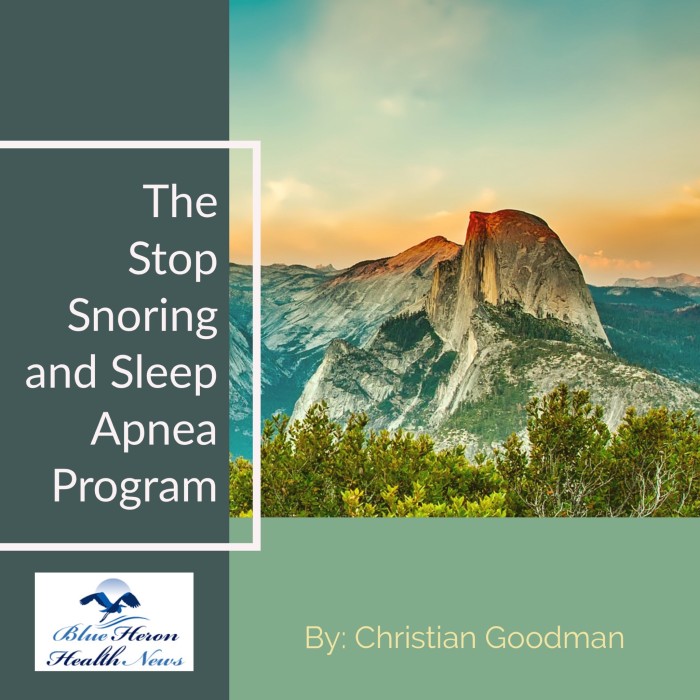This eBook from Blue Heron Health NewsBack in the spring of 2008, Christian Goodman put together a group of like-minded people – natural researchers who want to help humanity gain optimum health with the help of cures that nature has provided. He gathered people who already know much about natural medicine and setup blueheronhealthnews.com. Today, Blue Heron Health News provides a variety of remedies for different kinds of illnesses. All of their remedies are natural and safe, so they can be used by anyone regardless of their health condition. Countless articles and eBooks are available on their website from Christian himself and other natural health enthusiasts, such as Julissa Clay , Shelly Manning , Jodi Knapp and Scott Davis. The Stop Snoring And Sleep Apnea Program™ By Christian Goodman The Stop Snoring and Sleep Apnea Program is a well-researched program created to help stop snoring and sleep apnea so that you can have a good night sleep. The techniques that you will learn from this program works immediately. It will only take you 3-7 minutes to perform these simple exercises that the author has recommended but the results that you will get will help you have a good night sleep as soon as tonight. Within a week, snoring will be a thing of the past.
|
Workplace Accommodations for Sleep Apnea
Sleep apnea accommodations in the workplace are meant to assist people with their condition and maintain productivity and health at work. Employers are obligated generally to make a reasonable accommodation in disability law, like the Americans with Disabilities Act (ADA) in the U.S., where an employee is documented as having a disability, including sleep apnea. These are some usual workplace accommodations for people with sleep apnea:
1. Flexible Scheduling
Flexible working hours: Allowing the employees to schedule their start and end of their work to adapt to their sleeping routine can help reduce fatigue.
Day breaks: Providing added short breaks will allow the employees to rest and deal with fatigue, especially where they struggle to remain awake as they sleep insufficiently.
2. Permission to Nap or Rest Break
Midday naps: In some cases, allowing an employee to take a short nap during breaks can help in reducing excessive daytime sleepiness and improve concentration.
Quiet space: An area where an employee can take a short break if needed.
3. Remote or Telecommuting Options
Work from home: Wherever possible, work-from-home options can allow employees to manage their symptoms more effectively, especially if they become too fatigued or need to alter their sleep schedule.
4. Ergonomic Workspace Adjustments
Adjusted lighting: Appropriate lighting at the workplace to prevent eye strain and reduce fatigue.
Seating adjustments: Ergonomic seats or seating that enables better posture, which can improve breathing and comfort in the workplace.
5. Sleep Apnea Equipment for Management
CPAP machine: Employees with sleep apnea may require a Continuous Positive Airway Pressure (CPAP) machine. Employers may have to provide a private space for the usage of the machine in case it is required during working hours (though it is most commonly used overnight).
Portable devices: Providing the opportunity to charge or use equipment like CPAP machines or other sleep equipment can be a proper accommodation.
6. Modified Job Tasks or Responsibilities
Task modifications: Employees who are extremely fatigued may benefit from reduced physical work or workload modification during severe fatigue periods.
Shift work modifications: Employees working the night shift may need adjustments to shift to the day shift or to eliminate long shifts, as night shifts exacerbate sleep apnea symptoms.
7. Education and Awareness for Coworkers
Awareness programs: Providing educational resources or training to other employees about sleep apnea and its impact can foster a more supportive environment.
Confidentiality: Maintaining the confidentiality of sleep apnea employees to prevent stigmatization and foster a supportive company culture.
8. Time off for Medical Appointments
Leave for doctor appointments: Employees with sleep apnea may need to take time off for doctor appointments for their condition, like sleep studies, follow-up appointments, or CPAP adjustments.
9. Light Duty or Temporary Accommodations
Temporary reassignment: If an employee is experiencing severe symptoms or exhaustion, he or she may need temporary reassignment to lighter tasks until his or her condition improves with treatment.
10. Open Communication with Management
Open communication: Invite employee-supervisor communication for the resolution of matters and discussion of accommodations. Employees should feel comfortable sharing their needs and employers should be helpful in their responses.
With these accommodations in place, employers can enable employees to manage their sleep apnea while they continue to perform work effectively and have enhanced quality of life on the job.
Sleep apnea patients have some legal rights to protect their health, privacy, and workplace adjustments. Such rights vary in countries, but in most places, including the United States and Europe, there are legislations to provide appropriate treatment, nondiscrimination protection, and accommodation in the workplace for individuals with sleep apnea. Some of the key legal rights of sleep apnea patients are elaborated below:
1. Protection against disability
Americans with Disabilities Act (ADA) (U.S.):
Sleep apnea can be a disability under the ADA, particularly if it greatly limits a person’s ability to participate in substantial life activities such as sleeping, working, or social interaction.
Reasonable accommodations must be made at the workplace for employees who have sleep apnea. This can be through flexible scheduling, the ability to nap, or changes in job duties if work performance is impacted by the disorder.
Equal Treatment Laws (Europe):
Most European countries share the same disability protections, which state that long-term medical illnesses such as sleep apnea qualify as a disability if they affect one’s life significantly. Sleep apnea patients are entitled to reasonable adjustments at work.
Social Security Disability Benefits (U.S.):
In certain cases, sleep apnea can be very severe, leading to complications such as cardiovascular disease or excessive daytime sleepiness that prevents working and qualifies a person for Social Security Administration (SSA) disability benefits.
2. Rights in the Workplace
Occupational Health & Safety:
Employers typically have the responsibility of maintaining a safe work environment, and this includes supporting patients with sleep apnea who can experience daytime fatigue, impaired concentration, or other symptoms that can affect work performance.
In a few professions (e.g., truck driving), untreated sleep apnea poses a threat to public safety. Employers must work with employees on safety and treatment compliance. Sleep apnea sleepers, such as truck drivers or pilots, may have to demonstrate that their sleep apnea is in control (e.g., through CPAP therapy) in order to continue working.
FMLA (Family and Medical Leave Act) (U.S.):
If sleep apnea necessitates surgery, treatment, or hospitalization, workers can be entitled to medical leave under the FMLA, which allows eligible employees to take up to 12 weeks of unpaid leave for medical treatment without jeopardizing their employment.
3. Insurance Rights
Health Insurance Coverage:
In most countries, including the US, health insurance policies are mandated to pay for diagnosis and treatment of sleep apnea, such as expenses for CPAP therapy, sleep tests (polysomnography), and other medically necessary treatment.
Affordable Care Act (ACA) also mandates health insurance policies to include coverage of sleep disorder treatment, like sleep apnea, in essential health benefits.
Most private health insurance providers and state-subsidized health programs (such as Medicaid) also pay for the costs of CPAP machines, surgery, and sleep apnea medication.
Short-Term Disability:
A few firms or policies may offer short-term disability coverage for individuals with extreme sleep apnea, especially if it causes chronic fatigue, sleep disruption, or other accompanying medical conditions that prevent one from working.
4. Privacy Rights
Health Insurance Portability and Accountability Act (HIPAA) (U.S.):
Under HIPAA, sleep apnea patients have the right to confidentiality of their health information. Medical professionals and employers are also obligated to protect the privacy of an individual’s healthcare information and never reveal information regarding sleep apnea without the patient’s consent, except in specific situations.
General Data Protection Regulation (GDPR) (Europe):
In Europe, the GDPR is strict in dictating the processing and disclosure of personal health information, including sleep apnea diagnosis and treatment. The consent of the individual must be obtained before disclosing any health information.
5. Treatment and Access to Care
Access to CPAP Machines and Treatment:
Sleep apnea victims have the right to access medically necessary treatment for their condition. This translates to the fact that they can be prescribed CPAP units and use them, and that patients have the right to have the units paid for under insurance in most regions.
Fair treatment: In some regions, patients have legally protected rights to fair treatment in access to treatment, in that they cannot be discriminated against for receiving or access to treatment.
6. Anti-Discrimination Protections
Workplace Non-Discrimination:
The ADA prohibits discriminatory treatment of individuals with sleep apnea, preventing them from being treated unfairly in hiring, firing, or job placement because of their condition.
Employers cannot refuse to hire an employee solely because of a diagnosis of sleep apnea, provided the condition does not severely affect an employee’s capacity to perform essential job duties even with proper accommodations.
7. Access to Education
Student Accommodations:
In some countries, students with sleep apnea may be eligible for accommodations in school. For instance, a student who is drowsy during the day may be given extra time to take tests or other accommodations to help with their condition while in school.
Sleep apnea patients are protected by several laws that ensure fair treatment and access to necessary care, but specific rights can vary depending on location and individual circumstances. If you need help navigating specific legal protections, consulting with a healthcare attorney or disability advocate can be beneficial.
Let me know if you want more information on any specific legal rights or protections!

The Stop Snoring And Sleep Apnea Program™ By Christian Goodman The Stop Snoring and Sleep Apnea Program is a well-researched program created to help stop snoring and sleep apnea so that you can have a good night sleep. The techniques that you will learn from this program works immediately. It will only take you 3-7 minutes to perform these simple exercises that the author has recommended but the results that you will get will help you have a good night sleep as soon as tonight. Within a week, snoring will be a thing of the past.
This eBook from Blue Heron Health NewsBack in the spring of 2008, Christian Goodman put together a group of like-minded people – natural researchers who want to help humanity gain optimum health with the help of cures that nature has provided. He gathered people who already know much about natural medicine and setup blueheronhealthnews.com. Today, Blue Heron Health News provides a variety of remedies for different kinds of illnesses. All of their remedies are natural and safe, so they can be used by anyone regardless of their health condition. Countless articles and eBooks are available on their website from Christian himself and other natural health enthusiasts, such as Julissa Clay , Shelly Manning , Jodi Knapp and Scott Davis. |
